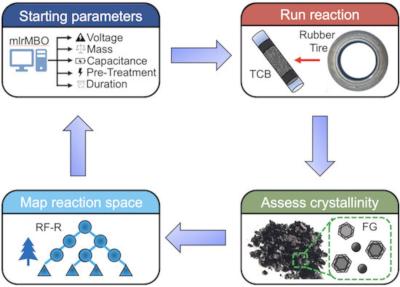Scientists at Rice University are using machine-learning techniques to fine-tune the process of synthesizing graphene from waste through flash Joule heating. The researchers describe in their new work how machine-learning models that adapt to variables and show them how to optimize procedures are helping them push the technique forward.
 Machine learning is fine-tuning Rice University’s flash Joule heating method for making graphene from a variety of carbon sources, including waste materials. Credit: Jacob Beckham, from: Phys.org
Machine learning is fine-tuning Rice University’s flash Joule heating method for making graphene from a variety of carbon sources, including waste materials. Credit: Jacob Beckham, from: Phys.org
The process, discovered by the Rice lab of chemist James Tour, has expanded beyond making graphene from various carbon sources to extracting other materials like metals from urban waste, with the promise of more environmentally friendly recycling to come. The technique is the same: blasting a jolt of high energy through the source material to eliminate all but the desired product. However, the details for flashing each feedstock are different.
"In the coming years, the flash parameters can vary depending on the feedstock, whether it's petroleum-based, coal, plastic, household waste or anything else," he said. "Depending on the type of graphene we wantâsmall flake, large flake, high turbostratic, level of purityâthe machine can discern by itself what parameters to change."
Because flashing makes graphene in hundreds of milliseconds, it's difficult to follow the details of the chemical process. So Tour and company took a clue from materials scientists who have worked machine learning into their everyday process of discovery.
"It turned out that machine learning and flash Joule heating had really good synergy," said Rice graduate student and lead author Jacob Beckham. "Flash Joule heating is a really powerful technique, but it's difficult to control some of the variables involved, like the rate of current discharge during a reaction. And that's where machine learning can really shine. It's a great tool for finding relationships between multiple variables, even when it's impossible to do a complete search of the parameter space". "That synergy made it possible to synthesize graphene from scrap material based entirely on the models' understanding of the Joule heating process," he explained. "All we had to do was carry out the reactionâwhich can eventually be automated."
The lab used its custom optimization model to improve graphene crystallization from four starting materialsâcarbon black, plastic pyrolysis ash, pyrolyzed rubber tires and cokeâover 173 trials, using Raman spectroscopy to characterize the starting materials and graphene products.
The researchers then fed more than 20,000 spectroscopy results to the model and asked it to predict which starting materials would provide the best yield of graphene. The model also took the effects of charge density, sample mass and material type into account in their calculations.
Lat month, the Rice team developed an acoustic processing method to analyze LIG synthesis in real time.